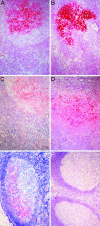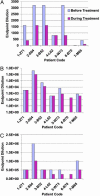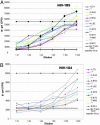Persistence of HIV-1 structural proteins and glycoproteins in lymph nodes of patients under highly active antiretroviral therapy
- PMID: 16199516
- PMCID: PMC1253583
- DOI: 10.1073/pnas.0506857102
Persistence of HIV-1 structural proteins and glycoproteins in lymph nodes of patients under highly active antiretroviral therapy
Abstract
Here we report a long-term persistence of HIV-1 structural proteins and glycoproteins in germinal centers (GCs) of lymph nodes (LNs) in the absence of detectable virus replication in patients under highly active antiretroviral therapy (HAART). The persistence of viral structural proteins and glycoproteins in GCs was accompanied by specific antibody responses to HIV-1. Seven patients during the chronic phase of HIV-1 infection were analyzed for the presence of the capsid protein (HIV-1p24), matrix protein (HIV-1p17), and envelope glycoproteins (HIV-1gp120/gp41), as well as for viral RNA (vRNA) in biopsy specimens from LNs obtained before initiation of therapy and during HAART that lasted from 5 to 13 months. In parallel, these patients were also monitored for viremia and specific anti-HIV-1 antibody responses to structural proteins and glycoproteins both before and during treatment. Before-therapy viral levels, as determined by RT-PCR, ranged from 3 x 10(3) to 6.3 x 10(5) copies of vRNA per ml, whereas during treatment, vRNA was under detectable levels (<25 copies per ml). The pattern of vRNA detection in peripheral blood was concordant with in situ hybridization results of LN specimens. Before treatment, vRNA associated with follicular dendritic cells (FDCs) was readily detected in GCs of LNs of the patients, whereas during therapy, vRNA was consistently absent in the GCs of LN biopsies of treated patients. In contrast to vRNA hybridization results, viral structural proteins and glycoproteins, evaluated by immunohistochemical staining, were present and persisted in the GC light zone of LNs in abundant amounts not only before initiation of therapy but also during HAART, when no vRNA was detected in GCs. Consistent with immunohistochemical findings, specific antibody responses to HIV-1p17, -p24, and -gp120/gp41, as evaluated by ELISA and virus neutralization, persisted in patients under therapy for up to 13 months of follow-up. The implications of these findings are discussed in relation to HIV-1 persistence in infected individuals and the potential role of chronic antigenic stimulation by the deposited structural proteins in GCs for AIDS-associated B cell malignancies.
Figures




References
-
- Lane, H. C., Masur, H., Edgar, L. C., Whalen, G., Rook, A. H. & Fauci, A. S. (1983) N. Engl. J. Med. 309, 453-458. - PubMed
-
- Pahwa, S. G., Quilop, M. T., Lange, M., Pahwa, R. N. & Greico, M. H. (1984) Ann. Intern. Med. 101, 757-763. - PubMed
-
- Martinez-Maza, O., Crabb, E., Mitsuyashu, R.T., Fahey, J. L. & Giorgi, J. V. (1987) J. Immunol. 138, 3720-3724. - PubMed
-
- Amman, A. J., Schiffman, G., Abrams, D., Volberding, P., Ziegler, J. & Connant, M. (1984) J. Am. Med. Assoc. 251, 1447-1449. - PubMed
Publication types
MeSH terms
Substances
Grants and funding
LinkOut - more resources
Full Text Sources
Medical
Miscellaneous

